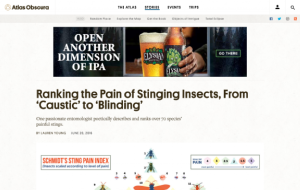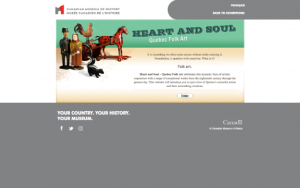|
Help |
Site Map
|
|

|
|
JEWISH WARSAW
|
SOCIAL STUDIES |
|
|
|
From the POLIN Museum of the History of Polish Jews comes Jewish Warsaw, a powerful online exhibit that allows visitors around the world to learn about the history of Warsaw through the eyes of historical and contemporary Jewish individuals. This three-part project utilizes Google Maps, archival material from the POLIN Museum, and original comics. In the first part, visitors learn about the life and work of Janusz Korczak via an interactive timeline and historic map of Warsaw that allows users to visit important sites in Korczak's life. Tragically, Korczak, who founded a children's magazine and directed an orphanage, was murdered at Treblinka extermination camp in 1942. Next, in Stories and Sketches, visitors can explore original comics, authored by Monika Powalisz and drawn by Jacek Michalski, that tell the story of nine individuals "who greatly influenced the social and cultural life" of Warsaw. By clicking on a series of links embedded in the comics, visitors can view related materials and learn more. Finally, Past and Present reveals three virtual tours of Warsaw: Common History: 1414-1939, Holocaust: 1939-1945, and Our Varshe: 1945-2016. Historical documents, sketches, photographs, and video clips are incorporated into the tours. [MMB]
|
|
|
|
|
 |
|
 |
|
ATLAS OBSCURA: RANKING THE PAIN OF STINGING INSECTS, FROM 'CAUSTIC' TO 'BLINDING'
|
SCIENCE |
|
|
|
Justin Schmidt is an entomologist with a job that few would envy: he classifies the level of pain of insect stings on a scale that is colloquially referred to as the Schmidt Sting Pain Index. As part of his research, Schmidt has experienced no fewer than 1,000 stings in his lifetime. In this fascinating article from Atlas Obscura, visitors can learn more about Schmidt's work and explore a detailed chart of his Pain Index. This chart shows thirty insects and their ranking from 1 (least painful) to 4 (most painful). Each insect is also accompanied by a colorful description. For example, the Iridescent Cockroach Hunter is described as "Itchy with a hint of sharpness. A single stinging nettle pricked your hand." In contrast, the Red Paper Wasp, which ranks as a formidable 3, is described as "Caustic and burning. Distinctly Bitter aftertaste. Like spilling a beaker of hydrochloric acid on a paper cut." [MMB]
|
|
|
|
|
 |
|
HEART AND SOUL: QUEBEC FOLK ART
|
ARTS |
|
|
|
"Folk art is a reflection of society as seen through the eyes of artists whose perceptions are sometimes traditional and conventional - sometimes unruly, and even wild." So writes the Canadian Museum of History, host of this online exhibit that highlights Quebec folk art from the eighteenth century through today. This exhibit allows visitors to explore the diversity of folk art through both themed galleries and artist profiles. For example, the Traditional Approaches gallery features a range of works that employ traditional artistic methods. These include sculptures, a hand-crafted violin case, and nativity scenes created each December in the village of Saguenay. Meanwhile, the World According To... section features quotes and artwork by folk artists with contrasting philosophies. Another highlight of this online exhibit is the Tribute to Nettie Covey Sharpe, where readers will find biographic information about the women who collected and curated over 1,000 pieces of Quebec folk art. [MMB]
|
|
|
|
|
 |
|
ON POINT: REDISCOVERING AFRICAN-AMERICAN ROOTS AND CUISINE
|
SOCIAL STUDIES |
|
|
|
Michael Twitty is a culinary/cultural historian, a chef, and an interpreter at Colonial Williamsburg's Peyton Randolph kitchen. Twitty recently appeared on NPR's On Point to discuss his latest book, The Cooking Gene: A Journey Through African-American Culinary History in the Old South. and his views on antebellum southern history. In this interview he explains how enslaved African-Americans created contemporary American southern cuisine. For example, Twitty describes the roles of James Hemings, the enslaved chef of Thomas Jefferson, and Hercules, the enslaved chef of George Washington, in creating a cuisine that blended techniques and ingredients from European and Afro-Virginian cultures. This cuisine might be considered proto-soul food; both chefs made collard greens, and Hemmings made a macaroni pie that was not entirely unlike macaroni and cheese. Twitty explains that, in his mind, soul food can be defined as "memory cuisine of the great-grandchild of enslaved people." Interested readers can listen to the entire conversation here and check out a number of related resources, including some of Twitty's recipes and his 2016 TED talk about culinary justice. [MMB]
|
|
|
|
|
 |
|
THE METROPOLITAN MUSEUM OF ART: RUMINATIONS
|
ARTS |
|
|
|
The Metropolitan Museum of Art is home to almost 12,000 pieces of Islamic art, created between the seventh and nineteenth centuries. RumiNations is The Met's blog dedicated to this art collection. Here, visitors can find detailed descriptions, analyses, and histories of these works. For example, one recent post explores an illustrated manuscript for Farid al-Din 'Attar's The Conference of the Birds, "one of the most adored masterpieces of Islamic literature." Another post discusses the Company School paintings that emerged from late eighteenth century India and blended aesthetic techniques and conventions from the Mughal Empire with European conventions. The Met currently has a special exhibit of Company School paintings, which will run through October 1, 2017. Readers will also find an interview with printmaker Zarina Hashmi, whose work is featured in a 2017 Met exhibition. [MMB]
|
|
|
|
|
 |
|
COMING SOON? A SOLAR ECLIPSE NEAR YOU
|
SCIENCE |
|
|
|
As folks prepare for the the August 21, 2017 total solar eclipse, Scientific American offers this interactive map where visitors may explore when each country in the world will experience a solar eclipse over the next 150 years. This map is accompanied by a handy diagram that explains the difference between various kinds of eclipses, including total, annular, and hybrid, which are all classified as "central eclipses." On the global map, visitors can view the paths of future solar eclipses and zoom in on a country of interest. The paths of these eclipses are color coded to identify the kind of eclipse they represent and labeled by the year they will appear. [MMB]
|
|
|
|
|
Copyright © 2017 Internet Scout Research Group - http://scout.wisc.edu: The Internet Scout Research Group, located in the Computer Sciences Department at the University of Wisconsin-Madison, provides Internet publications and software to the research and education communities under grants from the National Science Foundation, the Andrew W. Mellon foundation, and other philanthropic organizations. Users may make and distribute verbatim copies of any of Internet Scout's publications or web content, provided this paragraph, including the above copyright notice, is preserved on all copies. Pages: 1 · 2
Culture and Arts, Art and Museums, Literature and Poetry, History, Culture Watch, Garden, The Internet, Employment, Learning, Senior Women Web, Articles, Sightings, What's New
|
|















